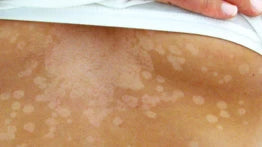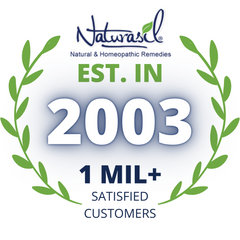What is tinea versicolor?
Tinea versicolor is a fungal infection of the skin caused by the Malassezia strain of yeast that lives naturally on your body. [1] Usually, this fungus lives harmlessly and without detection on your skin; however, when certain conditions cause this fungus to grow faster than usual, it causes symptoms that you may recognize as tinea versicolor. Though the condition is not contagious, it can be unpleasant and affect your confidence levels due to the aesthetic changes that the fungal overgrowth causes.
Symptoms of tinea versicolor
The most common symptom of tinea versicolor is a hypopigmented or hyperpigmented rash occurring in patches. This means that you have a patchy rash of discoloration on your skin, either darker or lighter than your usual skin color; this rash will not tan in the sun. It usually comprises small circular or oval patches of discoloration, and without treatment, over time, these patches can get bigger and join up to make much larger patches. [2] The rash could be pink, red, brown, or white and usually occurs on the chest, torso, back, or upper arms; sometimes it may also affect the face or neck. [3]
Though the symptoms are usually limited to skin discoloration, in rarer cases, the rash may be scaly, raised, or itchy. [4] It is also possible that you might see some hair loss in the areas of skin affected by the discoloration or scaling. [5] This hair will regrow after successful treatment.
The condition is usually harmless, but this aesthetic change to the skin may cause mental distress through insecurity or a loss of confidence - especially if the condition is left to worsen over time. Possible itching or discomfort may also have a negative effect on quality of life, so it is important to treat tinea versicolor as quickly as possible to stop it from getting worse and then take appropriate measures to prevent the condition from recurring.
What causes tinea versicolor?
Tinea versicolor is caused by an overgrowth of the Malassezia yeast that lives naturally on your skin. It is not unusual to find this fungus on the skin; in fact, it is one of many fungal strains that usually live harmlessly on the body. However, there are certain conditions that make this fungus more likely to overgrow, ultimately causing the symptoms of tinea versicolor.
These factors include having sweaty or oily skin; diabetes, steroid use, and conditions that cause a weakened immune system; hormonal changes, including the use of oral contraceptives; wearing tight clothes or face masks; and living in a hot, humid climate. [6] In fact, studies show that in tropical climates, as many as 50% of people may suffer from tinea versicolor, whereas in cooler, drier countries, this could be as low as 0.5% of people. [7]
The condition is most common in teenagers and adults aged up to 45 due to the slightly greasier or sweatier skin that is present in this stage of life. [8] In rarer cases, tinea versicolor can affect children and older people too, with under-14s representing 5% of cases of the condition. [9]It is also slightly more common in men than in women, due to the hormones and skin chemistry of men; people of all races are just as likely to get a case of tinea versicolor, though the discoloration may be more visible on certain skin colors. [10]
Tinea versicolor is not contagious because it is caused by your own natural fungi. Though studies have proven that living in close contact with a tinea versicolor sufferer is not a risk factor for developing it yourself, it is thought that the condition may run in families. [11] This means that if a parent or sibling has a case of tinea versicolor, you may find yourself more prone to developing a case of it, too.
How to treat tinea versicolor
Often, people with a case of tinea versicolor may feel a little anxious about whether or not the condition will be cured and if the skin will return to its usual tone. There is good news here: tinea versicolor is completely curable, and after treatment, the skin discoloration will fade until it has disappeared altogether.
In order to treat tinea versicolor, it is important to eliminate the fungal overgrowth. Studies have shown that antifungal treatment is vital for curing tinea versicolor. [12] While a range of treatments for tinea versicolor exist, unlike many over-the-counter treatments, Naturasil’s effective formulas use only natural, homeopathic ingredients. This helps our customers avoid harsh chemicals, uncomfortable side effects, and worsening the condition. Our treatments are suitable for regular use, and we will only use ingredients that are natural, well-known for their effectiveness, and entirely safe for your skin.
Harnessing the natural antifungal properties of sulfur, the first step in our Tinea Versicolor Total Control Pack is the Tinea Sulfur Soap. The sulfur will cleanse and disinfect the affected area, working to eliminate impurities, bacteria, and fungi on your skin. This targets the fungal overgrowth at its source while removing excess sebum on your skin, which is one of the factors that cause your skin to be oily and, thus, more prone to developing tinea versicolor in the first place.
Next, after drying the skin thoroughly, apply our Tinea Relief Lotion. With a recipe of all-natural ingredients, including nature’s best healers, tea tree, jojoba, and lavender, the relief lotion will nourish and rehydrate your skin. With quick absorption, the lotion relieves redness and itchiness, helping to soothe and smooth your skin while it fights the fungal infection. Finally, our Tinea Topical Oil should be applied evenly to the affected area two or three times per day using the handy applicator brush. The powerful antifungal properties of this oil offer relief from itching and discomfort while working on the fungal infection, helping to reduce inflammation and return your skin to its natural beauty.
While it could take a few weeks—or, in the most severe cases, up to a few months—for your tinea versicolor symptoms to completely disappear, some of our customers report seeing visible changes within 48 hours of using our products. Once the discoloration is completely gone, you can be sure that your natural levels of yeast are back under control. [13]
Will my tinea versicolor come back?
It is possible that you might see a recurrence of your tinea versicolor symptoms, particularly if you are still exposed to the risk factors that played a part in your current case. For example, if you live in tropical conditions, you may find that your symptoms come back in particularly humid seasons. One study found that around two-thirds of people who have had one case of tinea versicolor will have it again at some point in their lives. [14]Proper prevention, then, is key to keeping your complexion even and your skin soft and fungus-free.
There are plenty of preventative measures that you can take to keep your fungal levels under control. Where you can try to avoid excess sweating: One method is wearing loose clothing made of natural fibers like cotton or synthetic, sweat-wicking fabrics that work by drawing excess moisture away from your skin. If specific lotions are making your skin more oily, consider switching to an alternative product. Finally, make sure that you dry yourself thoroughly after washing to avoid any excess moisture staying on your body when you get dressed.
Though the fungus that causes tinea versicolor lives naturally on your skin, it is entirely possible to prevent future overgrowth and, thus, future cases of tinea versicolor. In order to regulate the yeast levels in your body and prevent this recurrence, we recommend taking two Naturasil Candida Support tablets every day. These tablets work by balancing the yeast levels in your body and promoting a healthy gut, thus limiting the chance of your natural fungi growing out of control in the future.
Our Tinea Versicolor Preventative Treatment Kit includes everything you need to keep your skin clean, soft, and fungus-free. When used regularly, our products are effective in preventing recurring cases of tinea versicolor and keeping the skin clear of other impurities. The sulfur compounds in the Advanced Tinea Sulfur Cleansing Bar will continue to keep your skin fungus regulated while also helping you maintain a clear complexion by eliminating bacteria and toxins. Next, the use of the Intensive Tinea Relief Lotion will keep your skin even and hydrated through all seasons while preventing the recurrence of any redness or scaliness of the skin.
Though it is not uncommon for tinea versicolor to recur, with proper preventative measures, the condition can be cured, and future cases can be prevented. As our products are safe for regular, continued use, you can keep your skin fungus-free regardless of your lifestyle or risk factors, with the knowledge that your body will remain nourished and rejuvenated, too.
[1] Leung, A.K.C., Barankin, B., Lam, J.M., Leong, K.F., and Hon, K.L. (2022). ‘Tinea versicolor: an updated review.’ Drugs in Context, 11.
[2] Mendez-Tovar, L.J. (2010). ‘Pathogenesis of dermatophytosis and tinea versicolor.’ Clinics in Dermatology, 28(2), 185-189.
[3] Savin, 1996.
[4] Borelli, et al. 1991.
[5] Leung, et al., 2022.
[6] Leung, et al., 2022.
[7] Ibid.
[8] Borelli, D., Jacobs, P.H., and NaIl, L. (1991). ‘Tinea versicolor: Epidemiologic, clinical, and
therapeutic aspects.’ Journal of the American Academy of Dermatology, 25(2), 300-305.
[9] Savin, R. (1996). ‘Diagnosis and treatment of tinea versicolor.’ The Journal of Family Practice, 43(2), 127-132.
[10] Leung, et al., 2022.
[11] Borelli, et al. 1991.
[12] Savin, 1996.
[13] Leung, et al., 2022.
[14] Ibid.






